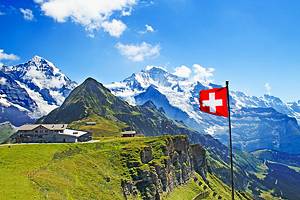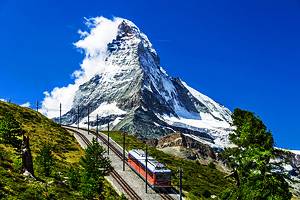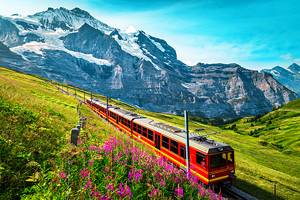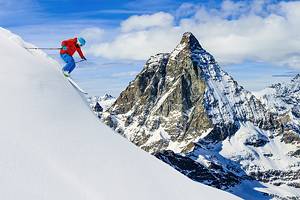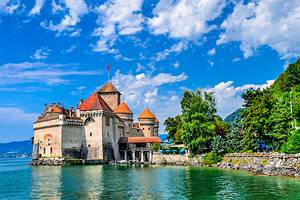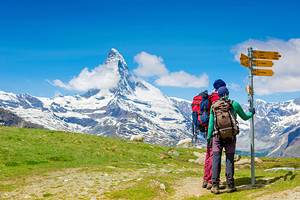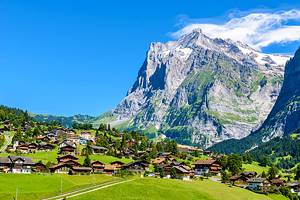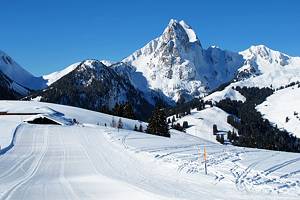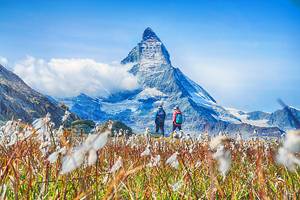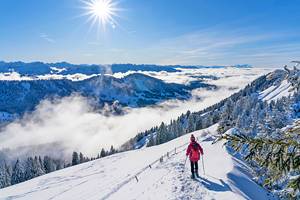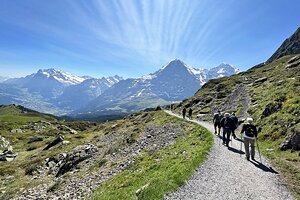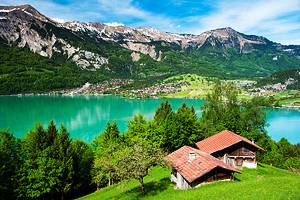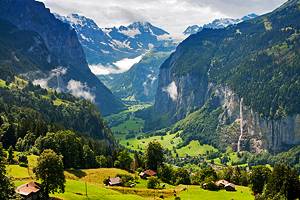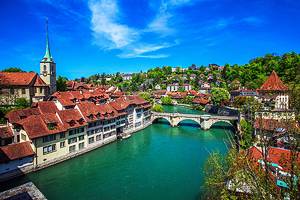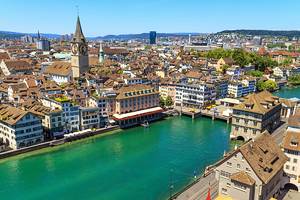Ski Resorts in Europe, 2024/25
The winter ski resorts of Europe's Alps and Dolomites are legendary, not only for their superb skiing but for the postcard Alpine villages and celebrity-studded resort towns at their bases. In the mountains of Italy, France, Switzerland, and Austria, you'll find some of the best ski resorts in the world.
Spectacular seems an inadequate description of the scenery, and lift systems at many of them make access between several mountains possible on a single trip — often in a single day. One ski run can take several hours, beginning high in the mountains and dropping right into the heart of the village below.
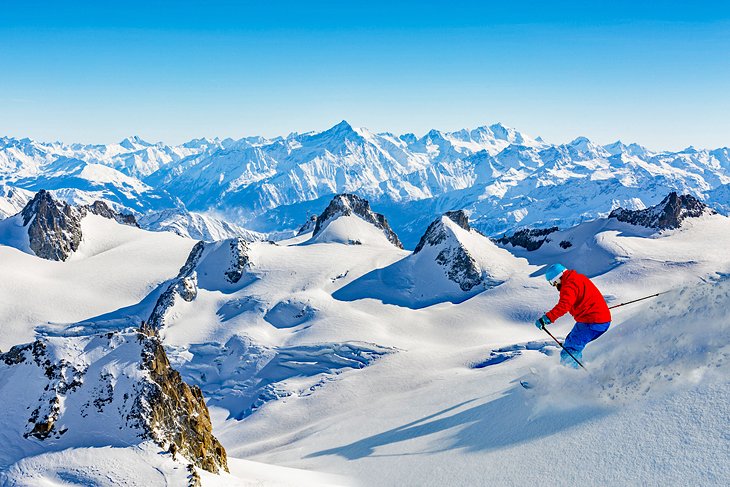
At many ski resorts in Europe, there's no excuse for repeating the same run twice during a vacation. High altitudes — more than a dozen peaks in Italy's Dolomites alone exceed 3,000 meters, and the Alps soar even higher — mean reliable snow conditions, so there's a long season when you can depend on gliding through powder.
Remember that these mountains are not just for expert skiers, although most are filled with challenges for the best of them: off-piste terrain, couloirs (narrow corridors), tree-studded steeps, and mega-moguls. Most resorts have easy and intermediate terrain, and many have dedicated slopes and lifts just for learners and beginners.
Each resort has its own character and style, not to mention incomparable views of snowcapped peaks. So choose according to your own personal tastes in a ski holiday — you won't be disappointed in the skiing at any of these outstanding resorts in France, Switzerland, Austria, Italy, and Germany.
Although the first consideration in the listings below is the skiing, the ratings also consider the quality of the whole experience for skiers in all skill ranges. Plan your next winter ski vacation with our list of the best ski resorts in Europe.
Courchevel, France
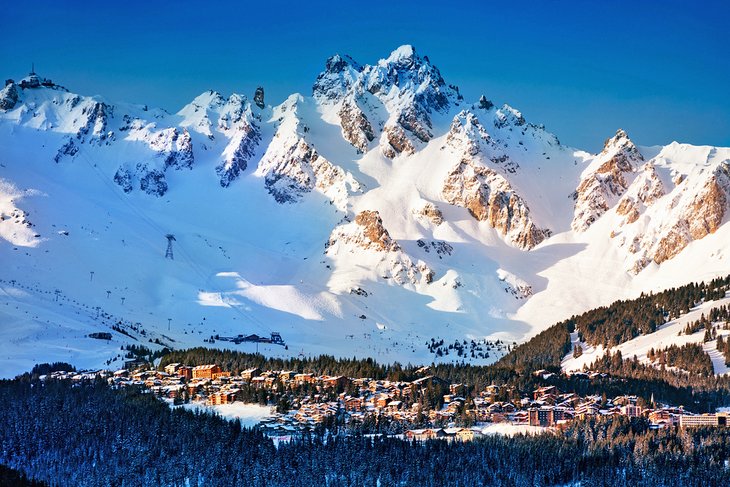
Courchevel is the largest and most famous of the several interlinked ski resorts known as Les Trois Vallées (Three Valleys), which form the largest ski domain in Europe. In addition to the 150 kilometers of alpine runs you can reach from Courchevel's own 60 lifts, these link into access to a total of 600 kilometers of interconnected ski runs, plus four glaciers. The entire area is spread across 10 summits, with altitudes above 2,500 meters.
Add to these superlative statistics the fact that the resorts get an annual snowfall of four meters and have state-of-the-art grooming to keep their runs in top condition.
Although Courchevel is a favorite of experts for its superb off-piste terrain, tree skiing, couloirs, mogul-studded steeps, each of Courchevel's five separate villages has good terrain for beginners and intermediates; about one-fourth of Courchevel's pistes are for beginners and one-third for intermediates.
Courchevel is especially family-friendly: free chairlifts serve the beginner areas, and magnetic safety vests for children are provided on lifts.
For the 2024/25 ski season the Saulire cable car is reopening. This stylish new lift features floor to ceiling windows with panoramic views of the surrounding peaks. The Three Valleys area also saw the addition of three 10-passenger gondolas last season.
In addition to its superlative skiing, Courchevel is renowned for its luxury accommodations and fine dining at several Michelin-starred restaurants.
Official site: www.courchevel.com
Zermatt, Switzerland
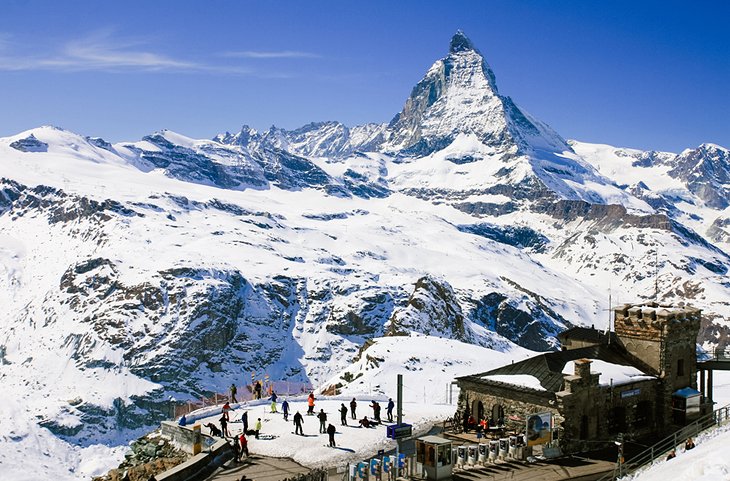
With Switzerland's greatest vertical drop and skiable terrain at altitudes as high as 3,900 meters, the highest winter sports area in the Alps has a lot more going for it than just a pretty face. But having the iconic landmark of the Matterhorn as a backdrop puts Zermatt and the mountainsides behind it on the top of most skiers' wish lists.
Not only does the Matterhorn give the town the most scenic setting of any in Europe, it's distinctive profile is visible from much of the 350-kilometer trail system connected to Zermatt.
Zermatt is known for its long runs, some of which end right in the village - you can literally ski home. The Matterhorn Glacier Ride, is the world's highest 3S cableway and carries 2,000 skiers an hour to the glacier. At an altitude of 3,883 meters, the glacier makes year-round skiing possible.
For less experienced skiers, Wolli's Park, at the top of the Sunnegga funicular, offers gentler terrain with the same smashing views. A year-round 100-passenger aerial tramway connects Zermatt with the Testa Grigia border station between Switzerland and Italy; a similar system on the other side will bring them back.
Zermatt is fashionable and high end and the prices reflect that cache. Be prepared to spend big if you want to ski here. But, if that doesn't faze you, the town has five Michelin-starred restaurants ready to delight your tastebuds and lighten your wallet.
Zermatt is a car-free village and the only access is via train or helicopter. Etaxis and ebuses operate within the village.
Zermatt is part of the IKON Pass program.
Official site: www.zermatt.ch
Val d'Isere, France
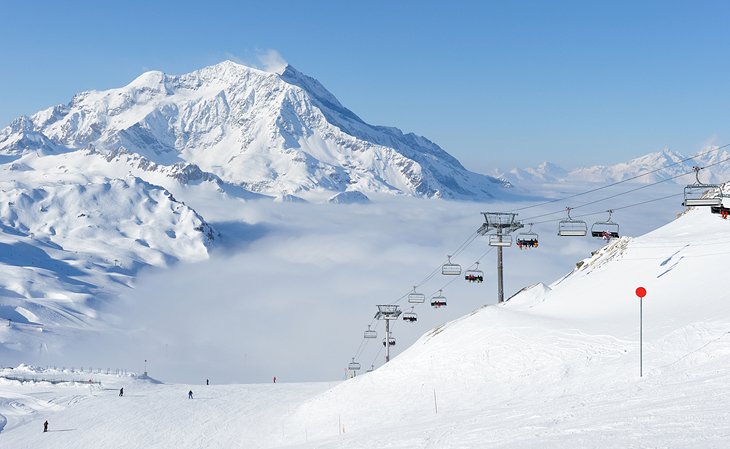
Sharing a high valley surrounded by 3,000-meter peaks, Val d'Isère and neighboring Tignes offer 300 kilometers of skiable terrain served by more than 150 ski lifts. This comprises the vast Espace Killy, named for Olympic triple gold medal winner Jean-Claude Killy, a native of Val d'Isère.
The lowest terrain is at an altitude of 1,550 meters, and the highest reaches to 3,450 meters, which helps keep the season open into May. You can usually be sure of skiing on the Glacier du Pisaillas into June or July.
There's terrain for all skill levels, including slopes for children and beginners. Youngsters can ride covered magic-carpet lifts to gentle downhill slopes, and ski instruction here is among the best.
A Travelator, an enclosed magic-carpet from the top of a gondola, accesses a gentle high-altitude slope, so even beginning skiers can enjoy the thrill - and the views - of high-altitude skiing. The layout of the lifts is very skier-friendly, connecting skiers to different areas without long, level catwalk trails.
The town is appealing, car-free, and known for its excellent restaurants, including seven that have earned Michelin stars.
Official site: www.valdisere.com/en
Cortina d'Ampezzo, Italy
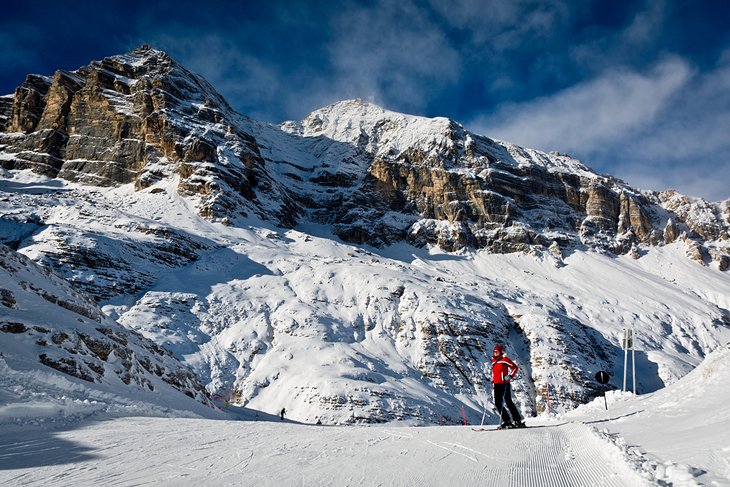
High in the Italian Dolomites, the five ragged peaks of the Cinque Torri provide the chic town of Cortina D'Ampezzo with a beautiful setting, as well as superb ski terrain. After the Winter Olympics were held here in 1956, the beautiful people followed, making Cortina, for many years, the preferred winter resort of the jet-setters. Although it now has a much broader clientele, it still has the chic shops and stylish entertainment venues you'd expect of a smart European ski resort.
But skiing is still the big draw. For all its Olympic-grade steeps and high-altitude snowfields, about half the skiable terrain is intermediate, and there is plenty of snow for beginners, too. Along with downhill skiing, Cortina offers miles of scenic cross-country ski trails, a bobsled run that is floodlit at night, and the Olympic rink for ice skaters.
Cortina is part of a dozen resorts sharing a single Dolomiti Superski Pass and the IKON Pass that gives access to the lifts and trails.
Trails and lifts link nearly 400 kilometers of interconnected skiing, including the Marmolada Glacier. The entire area has been named a UNESCO World Heritage Site.
Last season the 10-person Son dei Prade-Cianzopè-Bai de Dones gondola opened, connecting the Tofana with the Cinque Torri area. Skiers can now easily reach the Sellaronda and Dolomiti Superski areas from Cortina's village center.
Official site: https://www.dolomiti.org/en/cortina/
Chamonix, France
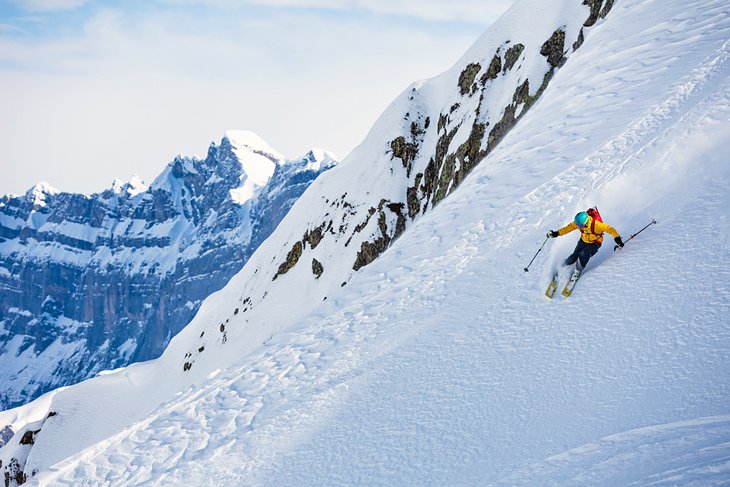
Its setting on snowcapped Mont Blanc, Europe's tallest peak at 4,807 meters, would make Chamonix a skiing icon, even without the quintessential French Alpine village that lies at its base. The altitude of the mountain and the glaciers around Chamonix have a cooling effect that preserves the snow, assuring it some of the best and longest-lasting snow conditions in the Alps.
Chamonix is huge, the entire area encompasses 29,405 acres with 67 lifts servicing 119 named runs.
Chamonix gained international fame as the site of the first Winter Olympics, fame which continued because it has some of the world's most challenging terrain. You can ski slopes with the world's greatest height differential at Grands Montets, one of the six different ski areas of Chamonix. The Verte piste, 3.5 kilometers of steeps and jumps, is used for World Cup races.
Less experienced skiers will like Brévent - Flégère areas, where they'll find slopes for all skiing levels, along with spectacular panoramic views from some of the trails.
Beginners will enjoy the gentle runs of the Balme – Vallorcine ski area, and families will find good learning facilities at Domaine Skiable des Planards or La Vormaine areas.
Chamonix is part of the IKON Pass program.
Official site: www.chamonix.com
- Read More: Tourist Attractions in Chamonix-Mont-Blanc
St. Anton am Arlberg, Austria
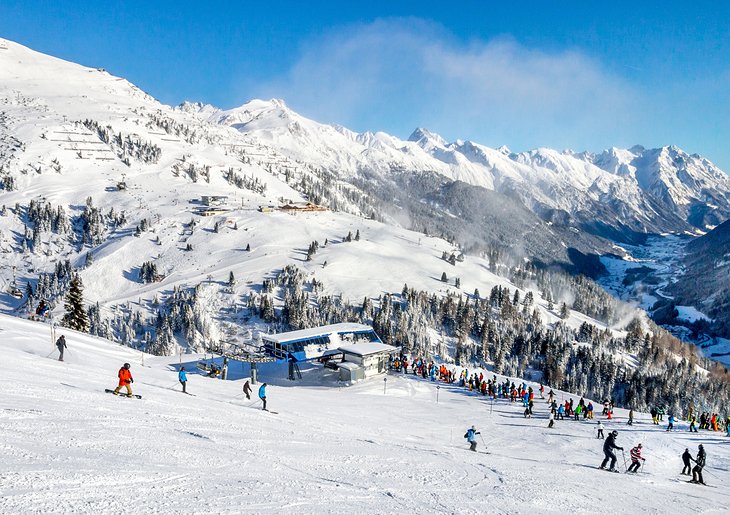
Serious skiers head to Austria's Arlberg region for no-nonsense high-challenge skiing, which they find on the more than a dozen super-expert runs at St. Anton. The longest of these is the demanding 10-kilometer Valluga-St. Anton, with an elevation differential of 1,347 meters.
But even the red-marked pistes here are well above the difficulty of other Alpine resorts. St. Anton is especially known for its roughly 200 off-piste options for advanced skiers - many are places to go with a guide - and its mega-moguls, especially on Schindler Kar.
Recently added lifts link St. Anton to ski pistes on the other side of the Flexen Pass, uniting it to the main resorts in the Arlberg: Lech, St. Christoph, Zürs, Stuben, and others for a combined total of 340 kilometers of pistes. These are all included in the regional Arlberg lift pass.
A spectacular 85-kilometer circuit, the Run of Fame, takes experienced skiers through the entire Ski Arlberg skiing area. The circuit runs from St. Anton/Rendl via Zürs and Lech to Warth, circling back to St. Anton. An annual race, the Hunt of Fame, will be held on the circuit.
You can board lifts right from the village, a traffic-free cluster of traditional Tyrolean lodges and inns, with a lively après-ski scene that makes it one of the best ski resorts in Europe for nightlife.
Official site: www.Stantonamarlberg.com
Kitzbühel, Austria
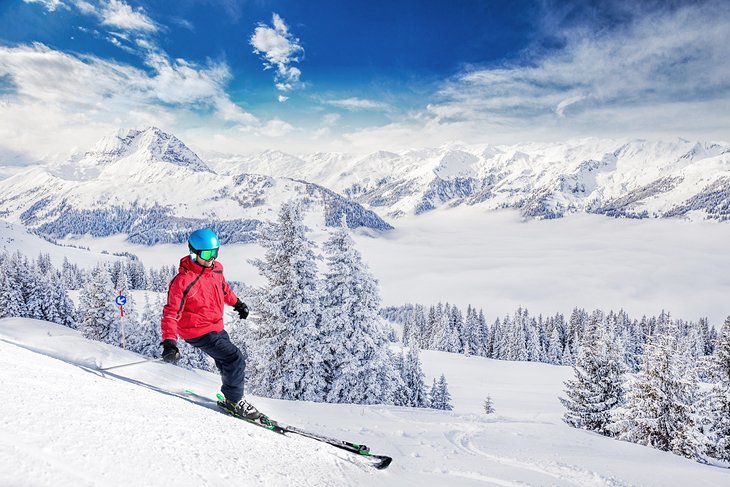
Ski towns don't get any prettier or more romantic than the walled village of Kitzbühel, in the Austrian Alps, not far from Innsbruck and Salzburg. Although its colorful, frescoed buildings house deluxe hotels and pricey shops like those of Cortina or St. Moritz, Kitzbühel also welcomes families and budget travelers with small family-run inns.
There's also something for all skiers in Kitzbühel's 170 kilometers of skiable pistes, and in the adjoining SkiWelt, where 280 more kilometers are served by 90 lifts.
The most challenging of all downhill races is held here annually, the notorious Hahnenkamm, on terrain as steep as 85 percent vertical in places. The small Bichlalm area is specially designed for riders and freestylers. Kitzbühel and the SkiWelt are connected by bus, and both are part of the Kitzbühel Alps AllStarCard, which includes nine different ski areas in Austria.
Kitzbühel is part of the IKON Pass program.
Official site: www.kitzbuehel.com
St. Moritz, Switzerland
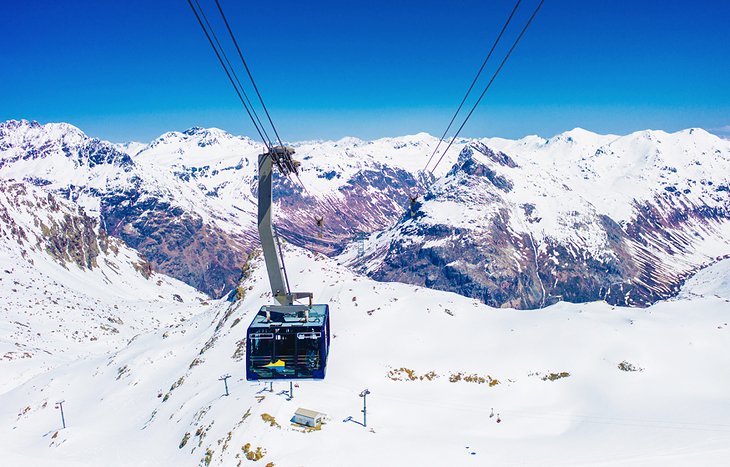
The number of world ski competitions that have been hosted at St. Moritz should tell you something about this famous resort: this is world-class skiing. The Winter Olympics were held here in 1928 and 1948, and you can often see competitions at its Olympic ski-jump.
There's plenty of ski terrain for non-Olympians, too. St. Moritz is known for its long intermediate runs and other outstanding intermediate terrain, and with more than 20 lifts to choose from, you'll find slopes and pistes for every skill level. Above St. Moritz and reached from town by the Corviglia Funicular, trails from the 2,486-meter town of Corviglia have magnificent Alpine views.
St. Moritz is one of Europe's first - some claim the first - winter resorts, and it still has a smart clientele and a distinct air of luxury. There are plenty of things to do besides skiing: ice skating, tobogganing, Nordic skiing, bobsledding, and kite skiing.
Despite the posh surroundings it is possible to ski for free here if you have an IKON Pass.
Official site: https://www.stmoritz.ch
Val Gardena, Italy

With the same world-class skiing as its neighboring Dolomite resort Cortina D'Ampezzo, but without the glitz or prices, the villages of Val Gardena offer a more casual, low-key experience.
Val Gardena's 160 kilometers of trails and lifts connect with those in several adjacent valleys between the peaks of the Gruppo del Sella, creating nearly 400 kilometers of interconnected skiing that includes the Marmolada Glacier. Nearly two-thirds of the terrain reached from Val Gardena is for advanced and expert skiers, one of the highest percentages in the Dolomites. But beginning and intermediate skiers still have more than 130 kilometers to enjoy.
Don't expect a vibrant nightlife in the villages of Ortisei, Santa Cristina, and Selva Val Gardena. Go to Cortina for that. Instead, you'll find a relaxing and friendly atmosphere of authentic Alpine hospitality, as well as small lodges and traditional inns serving local cuisine.
People come here for the skiing experiences, such as skiing four runs used for the men's and women's downhill and giant slalom World Championship races, with average gradients of more than 25 percent. The experts-only La Ria run, starting from the Dantercepies cable car, has inclines as great as 52 percent in places.
Along with ample natural snow and state-of-the-art grooming. Val Gardena's infrastructure is top-of-the-line. Its 81 lifts include Italy's first eight-seater chairlift with heated seats, on the Piz Sella, offering a direct connection to the Sellaronda route.
Val Gardena is included in the Dolomiti SuperSki pass, allowing access to 11 other resorts in the region.
Official site: https://www.valgardena.it
Zugspitze, Germany
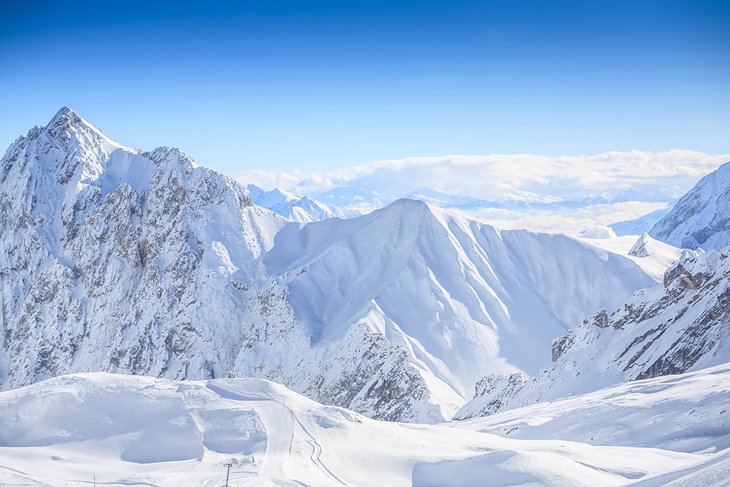
Rising to 2,962 meters, Zugspitze is Germany's highest mountain, and its popularity with skiers is enhanced by the beautiful Bavarian town of Garmisch-Partenkirchen at its foot. From its summit, which can now be accessed by a cable car, extends a 360-degree panorama that reaches as far as 250 kilometers and includes mountain peaks in four countries.
From the top of the lifts, you can ski the glacier, 2,700 meters above sea level - so high that it is often above clouds that cover the valley skies.
All levels of skiers will find plenty of choices in the 40 kilometers of trails at the Garmisch-Classic ski area, interlinked across three mountains: Hausberg, Kreuzeck, and Alpspitze. For extreme challenges, there's the famed Kandahar Downhill and other courses that were used in the 1936 Winter Olympics and since then for the International Alpine Skiing Championships.
A popular Olympic legacy is the Ice Stadium used for the 1936 Winter Games, now open for public skating. You can take lessons here at all levels, including speed skating and ice dancing. The area around Garmisch-Partenkirchen is networked with cross-country ski and snowshoe trails, and surrounded by spectacular Alpine views.
Courmayeur, Italy
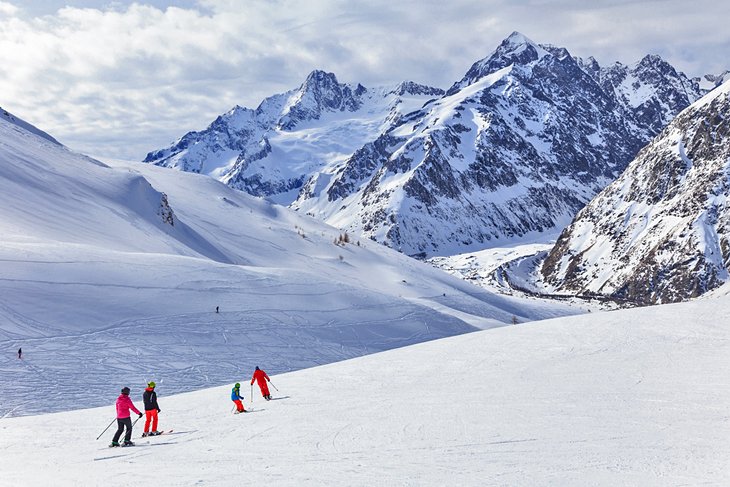
Combining the challenges of terrain best suited to experts and intermediates with the glamour of the most haute Swiss and French ski resorts, Courmayeur is the place to be seen for the upscale ski set from Milan and Turin.
The setting – and skiing – on the flank of Mont Blanc, the Alps' highest mountain, is an undeniable draw. With or without skis, ride the Funivie Monte Bianco cable car to the ridgeline for views from the top of Europe. The expert-only pistes from the Arp are unmarked and when they are open at all, you can only ski them with a guide; the same goes for Courmayeur's abundant off-piste ski terrain.
In nearby Dolonne are slopes suitable for beginners, but this region is better suited to experienced skiers. Nordic skiers, however, will love the 20-kilometer network of cross-country trails beginning in Val Ferret, just outside Courmayeur. The surrounding scenery doesn't get much better. As you might imagine from the clientele, lodging and dining in Courmayeur is pricey.
Grindelwald-Wengen and the Jungfrau, Switzerland
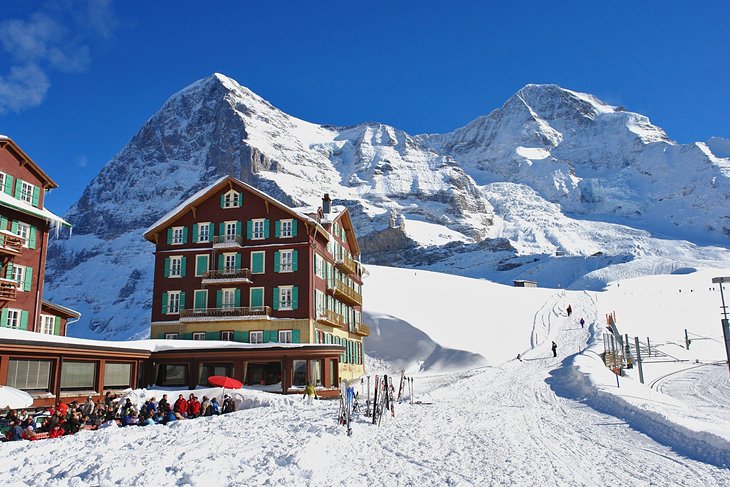
The multiple 400-meter-plus peaks of the Jungfrau massif can depend on reliably deep snow, and the ski resorts here are famed for their long runs. The steep slopes and high-altitude valleys offer skiers and boarders a combined total of 206 kilometers of ski runs, with idyllic little Alpine villages of chalets and lodges to come home to after a day in the snow.
From Lauterbrunnen or Grindelwald, you can ride to the Kleine Scheidegg to take the Jungfraubahn railway to the highest railroad station in Europe at 3,454 meters, or ride the funicular and narrow-gauge railroad from Lauterbrunnen to the car-free little village of Mürren for the even more challenging terrain of the Schilthorn, best known for its black-diamond Inferno run.
This is the site of the annual Inferno Race, the world's biggest amateur ski competition. Dozens of cable cars and lifts will take you to runs as long as 12 kilometers. It's not all white-knuckle steeps. Slopes close to the Alpine town of Wengen are good for beginning skiers and intermediates, while freestylers will find thrills at the Grindelwald-First superpipe and off-piste terrain.
Official site: https://jungfrauregion.ch/en/
- Read More: Tourist Attractions in the Jungfrau Region
Les Arcs and La Plagne, France
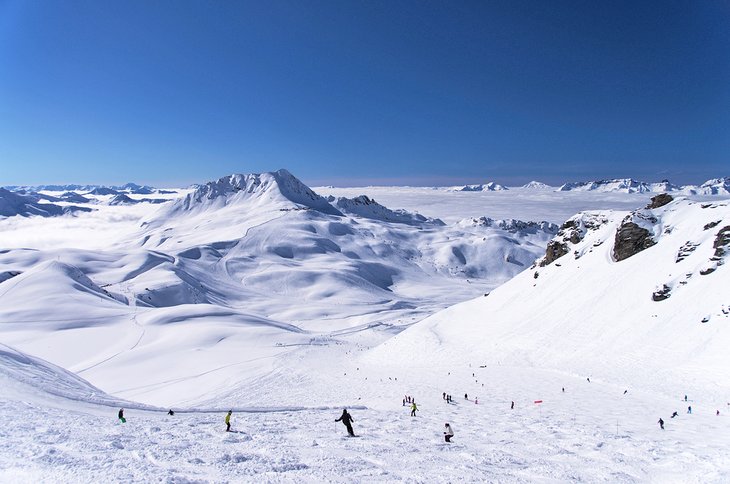
Part of the Paradiski area, one of France's largest linked ski domains, Les Arcs is linked to the resorts of La Plagne and Peisey-Vallandry for a combined ski terrain of runs totaling 425 kilometers. Les Arcs and La Plagne complement each other, between them offering top skiing for all skill levels.
The steep terrain at Les Arcs will keep experts happy on its long black runs and off-piste areas. Experienced intermediate skiers will appreciate the high-altitude open runs and the more sheltered woodland trails below, although some long narrow catwalks and fall-line runs will challenge less experienced intermediates.
Les Arcs is not a resort for beginning skiers, which is why its link to La Plagne makes such a perfect marriage. La Plagne is mainly for beginning and intermediate skiers, with gentle upper slopes and more challenges on the lower wooded trails.
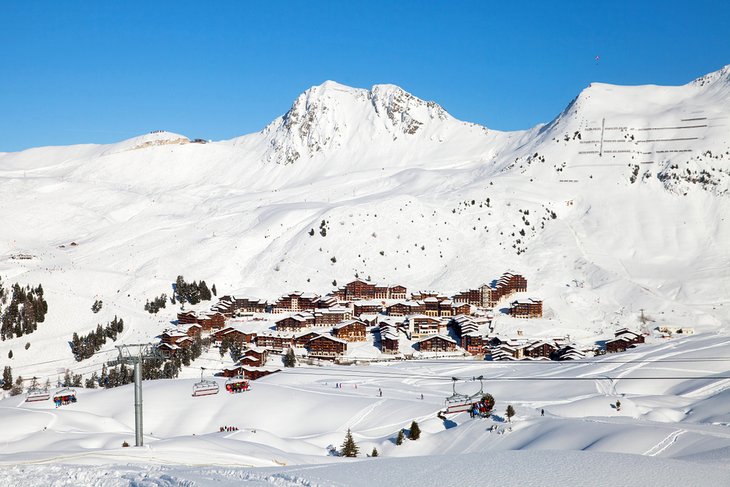
If they haven't opted for Les Arcs, experts can ski on the Bellecôte glacier at the top, where they'll find steeps and couloirs. Off-piste opportunities are excellent here, too.
Because of its more gentle terrain and kid-friendly vibe, La Plagne is one of the best ski resorts in Europe for families, with 11 villages offering ski-in/ski-out lodgings. Beginners can gain confidence on the gentle, well-groomed Fun Slope, where sculpted runs challenge novice skiers to develop their skills.
La Plagne's two terrain parks appeal to boarders and free-stylers, with Le Petit Park for beginning boarders and Le Grand Park at higher altitude featuring rails, tables, an airbag, and a boardercross course for experienced riders.
Major facility improvements continue at La Plagne, with a new chairlift to La Lovatière. Now getting between La Plagne Center and Champagny en Vanoise is a breeze. Last season, two gondolas, Glaciers 1 and 2, were added, as was the four-person Chalet de Bellecôte chairlift.
Official site: https://en.la-plagne.com/discover/ski-area
Breuil-Cervinia and Valtournenche
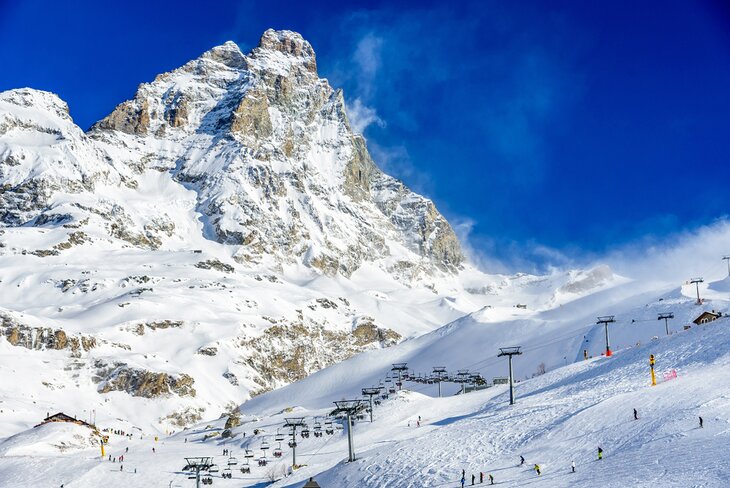
The prospect of skiing on Europe's most iconic mountain is almost irresistible to any avid skier. Although the best-known image of the Matterhorn is its distinctive sharp peak from the Zermatt side, the mountain is still impressive when viewed from the Italian side. It's easy to ski both sides in one day, beginning at the Italian ski resort of Breuil-Cervinia but be aware of the return time, miss it and you are in for a very expensive, (and long) taxi ride back to your hotel.
The Matterhorn Glacier Ride II connects the mountain station of the Swiss Matterhorn Glacier Paradise with the Testa Grigio/PlateauRosa station in Italy, the highest international border crossing in the Alps.
The town of Breuil-Cervinia is not as pretty as Zermatt, clustered under a sheer south face of the mountain, but its lower tourism profile means it's less crowded and less expensive than Zermatt.
The resort town of Valtournenche interlinks with Breuil-Cervinia, making a total of 23 lifts. The terrain at Valtournenche is less demanding, and a good choice for less experienced skiers and families. Few other places in Europe can offer 75km of pistes and slopes rated for beginners.
While Breuil-Cervinia and Valtournenche don't have the cache and glamour of Zermatt, they give skiers a taste of Alpine life with an Italian flair.
Official site: https://www.cervinia.it
Davos-Klosters, Switzerland
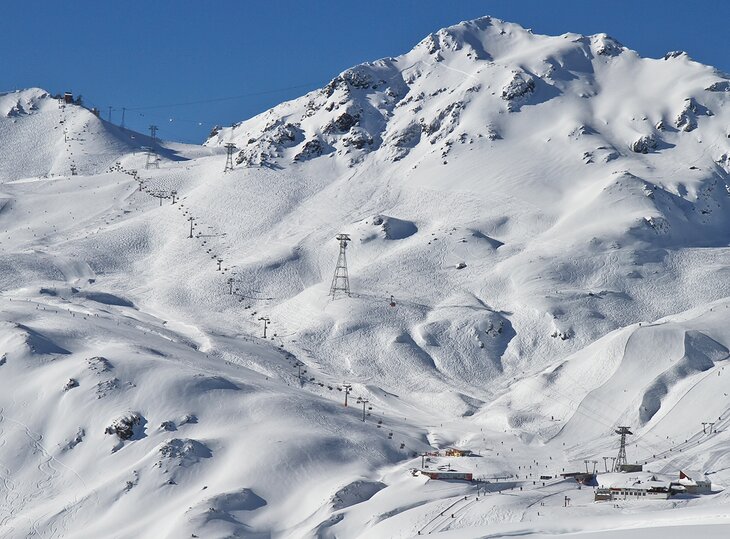
The high altitude and vast skiable area of the three linked towns of Davos, Klosters and Parsenn assure this fabled ski terrain of dependable snow. And, their more than 300 kilometers of groomed runs, much of them for intermediates, paired with breathtaking off-piste terrain, make this valley a destination for skiers of all skill levels.
Boarders and free-riders should head for Jakobshorn and to the Pischa area for off-piste free ride terrain. Nordic fans will like the 140 kilometers of cross-country ski trails at Davos, some lighted for night skiing.
For challenging terrain and some of the longest runs in the Alps, ski Parsenn, the town in the middle between the more famous names. The longest is 13 kilometers, dropping 2,034 vertical meters from Weissfluhgipfel to Küblis. A funicular railway and the Gotschna cable car make getting to the Parsenn terrain easy from either Davos or Klosters, so you can choose any town as a base.
If you're looking for an Alpine village setting, choose Klosters, although you can expect any of these resort towns to have the posh ambiance resulting from more than a century as a playground for royalty and celebs.
Official site: http://www.davos.ch/en/
Trail Ratings in Europe
North American skiers will find some differences in the trail rankings. In Europe, pistes are classified by a color-coded system indicated by blue (easy), red (intermediate), and black (expert) trail signs; note that these are not always coded by shapes. In France, most black trails are not groomed, and elsewhere ungroomed trails may be indicated by dotted or dashed lines.
More Ski Resorts in Europe to Consider

The total number of ski resorts in Europe is staggering, and even the number of full-service, international-class resorts is impressive, so the list above is not to suggest that these are the only places to find fantastic skiing and great winter vacation experiences. These popular resorts are also worth adding to your options.
Méribel, France: Of the several resorts sharing Europe's largest alpine ski domain, the enormous Les Trois Vallées, Méribel is the favorite for families, who prize its exceptional facilities for beginners and children. Superb natural snowfall and a variety of terrain give it plenty to attract even expert skiers, who get their thrills on a challenging 1,000-meter descent from Mont Vallon, through unparalleled Alpine scenery. More than 20 trails are marked for intermediate skiers, some of them broad cruisers at higher altitudes.
Official site: https://ski-resort.meribel.net/
Morzine, France: For the fun of cross-border skiing, few domains match the 12 Portes du Soleil resorts, with seven in France and five in Switzerland, several of them interconnected by lifts and pistes and by a region-wide ticket that includes 660 kilometers of slopes and 197 ski lifts. Morzine is on the French side, with 52 intermediate runs and nine each for beginners and experts.
Official site: http://en.morzine-avoriaz.com
Madonna di Campiglio, Italy: Resorts in the Brenta Dolomites, north of Verona, are less known than eastern Dolomite resorts, but Madonna di Campiglio offers some of Italy's best-groomed trails with the chic vibe of Cortina d'Ampezzo. More than 150 kilometers of trails and slopes, accessed by ski lifts right from the center of town, include expert-challenging runs reaching a 70 percent gradient. Die-hards can ski into the night on lighted trails, and the Ursus Snow Park is one of Europe's best for freestylers.
Official site: Madonna di Campiglio
Verbier, Switzerland: Experts take note: Verbier's long-distance runs and superb backcountry skiing make it one of the best resorts in the world for off-piste skiing. Add that to the Tortin, one of Europe's steepest descents. Verbier is part of the Four Valleys ski area, comprising more than 410 kilometers of ski runs accessed by 93 lifts, all on one lift pass.
Official site: https://www.verbier.ch
Davos-Klosters, Switzerland: One of Europe's largest ski resorts, the combined towns of Davos, Klosters, and Parsenn form a continuous line of skiing overlooking eastern Switzerland's Landwasser Valley.
Klosters is the best base, with its Alpine village charm and easy access to all three. The combined terrain exceeds 300 kilometers of groomed runs, with more than half of it designated for intermediates. Experts head to Parsenn, between Davos and Klosters, for the most challenging terrain and some of the longest runs in the Alps, one as long as 13 kilometers.
Official site: http://www.davos.ch/en/
Map of Ski Resorts in Europe
More Related Articles on PlanetWare.com
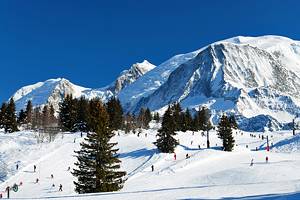
Ski in Europe: Each of these countries has many more ski resorts, and you can learn about them in our articles on the best ski resorts in France, Italy, Switzerland, and Austria.
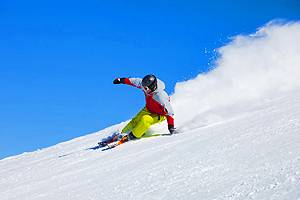
Ski USA: The Western United States has some of the best skiing in North America. For a look at the top ski resorts, see our articles on Utah, Colorado, and Lake Tahoe. If you are interested in skiing in New England and surrounding states, see our article on the East Coast Ski Resorts. For ideas on where to go to save money, see our article on the Cheap Ski Holidays in North America.


